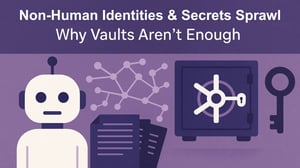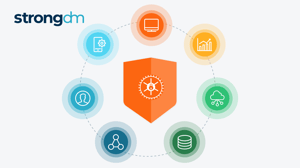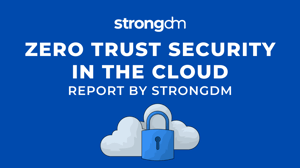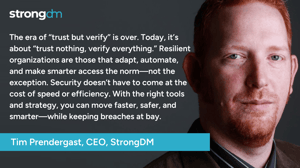Why Just-in-Time Access Is Key for Zero Trust Security in AWS


Written by
John MartinezLast updated on:
October 17, 2025Reading time:
Contents
Built for Security. Loved by Devs.
- Free Trial — No Credit Card Needed
- Full Access to All Features
- Trusted by the Fortune 100, early startups, and everyone in between
To operate effectively in the cloud, enterprises must provide access that is both instant and secure. Ensuring that users have the right permissions to complete their tasks efficiently while minimizing exposure, is central to any modern Zero Trust strategy. Traditional, perpetual access permissions can leave organizations vulnerable to misuse or attacks if access isn’t carefully managed and continually verified.
StrongDM’s Just-in-Time (JIT) access and approval requests meet this demand by providing access only when it’s needed, for as long as it’s required, and under the right conditions. This approach offers robust security while optimizing workflows, especially for AWS Data Plane resources like databases, servers, and Kubernetes clusters.
Why Just-in-Time Access Matters for Zero Trust Security
Zero Trust, as a security model, is built on the idea that no user or device should be trusted by default. Every access request must be continuously verified based on several factors, such as user identity, device health, and session context. Implementing Zero Trust in cloud environments requires a careful balance between user productivity and strict access controls—a balance that JIT access makes possible.
In a Zero Trust context, JIT access ensures that users only receive permissions exactly when they need them. Access is temporary, automatically expiring after a predefined period or when no longer in use, minimizing the risk of compromised credentials or excessive permissions. StrongDM’s JIT capabilities bring Zero Trust principles to complex environments like AWS, where resource sprawl and fluctuating permissions can easily lead to misconfigurations or excessive access.
In StrongDM, JIT access is managed through approval requests, allowing highly specific, time-bound access. StrongDM’s approach secures AWS Data Plane elements like databases, servers, and Kubernetes clusters while supporting Zero Trust principles.

The Secure Access Maturity Model is a roadmap for the journey to Zero Trust Access Management. Implementing JIT is key to getting there.
Key Elements of StrongDM’s Just-in-Time Access at the AWS Data Plane Layer
1. Session Management from Endpoint to Resource
Zero Trust requires detailed insight into every interaction between users and resources. In StrongDM, every access request starts and ends with comprehensive session management, logging every detail from endpoint to resource. This end-to-end visibility lets security teams see exactly who accessed what, when, and for how long, a fundamental requirement in Zero Trust environments. These session logs track activities across all AWS Data Plane resources, whether it’s SSH sessions for EC2 instances, queries to RDS databases, or commands executed in Kubernetes clusters, providing valuable data for auditing and anomaly detection.
2. Session Revocation for Real-Time Threat Response
In a Zero Trust model, any active session can be terminated instantly to contain threats as they arise. StrongDM’s session revocation capabilities allow admins to revoke access immediately. If a security alert or unusual activity is detected, active sessions can be automatically (or manually) terminated in real time. This real-time revocation adds a critical layer of control and security, especially in the AWS ecosystem where Zero Trust principles mean quickly containing potential breaches or suspicious behaviors. And when time-bound JIT sessions end? They’re also terminated in real-time, reducing the risk of persistent threats to your cloud.
3. Right Amount of Friction with MFA and Device Trust
One core tenets of Zero Trust is “Never trust, Always verify.” StrongDM JIT access integrates multi-factor authentication (MFA) and device trust as core verifications, adding the right amount of friction to ensure security without hindering productivity. Using StrongDM Policy-based Access Controls (PBAC), sessions can require MFA, whether a TOTP or push notification, ensuring that users accessing resources are who they claim to be. This adds a continuous verification layer, a crucial element in a Zero Trust model, where user identity must be continuously verified.
StrongDM’s device trust features extend this verification, checking the security posture of the user’s endpoint itself before access is granted, and during an active session. For instance, if a device does not meet security standards, access to AWS resources is denied, reducing the risk of unauthorized access. If device posture deteriorates during a session, that session is terminated and access revoked. This combined approach creates a minimal, intentional “speed bump” reinforcing security, perfectly aligning with Zero Trust tenets.
4. Comprehensive Audit Capabilities for Zero Trust Visibility and Compliance
A crucial component of Zero Trust is comprehensive visibility and accountability over all access activities. StrongDM’s audit capabilities fulfill this requirement by providing detailed logs and insights into every access request, revocation, session, and user action. These logs allow security teams to trace each user’s journey from request to resource, documenting every command, query, and modification made during a session. By preserving a full historical record, StrongDM’s auditing reinforces Zero Trust tenets such as continuous verification, least privilege, and incident response readiness.
The Zero Trust Advantage: Why Just-in-Time Access is Essential for Modern Security
In a cloud environment where multiple users can access resources continuously, managing access risks is paramount. StrongDM’s JIT access, with its session-specific, contextual verification, and device trust checks, aligns perfectly with the Zero Trust framework. By removing persistent access and continuously verifying user identities and device trust, JIT access reduces the attack surface and limits the scope of any potential breach.
StrongDM’s Just-in-Time (JIT) access and approval requests…[provide] access only when it’s needed, for as long as it’s required, and under the right conditions...
Final Thoughts: Enabling Productivity without Compromising Zero Trust Security
Zero Trust models often face the challenge of implementing rigorous security without slowing productivity. StrongDM’s Just-in-Time access model meets this challenge, delivering highly targeted, time-bound access under secure, controlled conditions when needed. By requiring access only as necessary and verifying every session, StrongDM ensures compliance with Zero Trust principles while empowering users to work efficiently.
For AWS environments—where resources like RDS databases, EC2 servers, and Kubernetes clusters demand strict security controls—StrongDM’s JIT access is a powerful, flexible solution. It offers the balance of security and accessibility that Zero Trust requires, seamlessly integrating security checks into the user experience.
StrongDM’s Just-In-Time access delivers Zero Trust access to critical cloud resources only when needed, for the duration required, and under the right conditions, creating a foundation for secure, streamlined cloud operations.
Book a demo of StrongDM and see how our Zero Trust PAM platform can provide what your legacy systems can’t.
Next Steps
StrongDM unifies access management across databases, servers, clusters, and more—for IT, security, and DevOps teams.
- Learn how StrongDM works
- Book a personalized demo
- Start your free StrongDM trial

Categories:

About the Author
John Martinez, Technical Evangelist, has had a long 30+ year career in systems engineering and architecture, but has spent the last 13+ years working on the Cloud, and specifically, Cloud Security. He's currently the Technical Evangelist at StrongDM, taking the message of Zero Trust Privileged Access Management (PAM) to the world. As a practitioner, he architected and created cloud automation, DevOps, and security and compliance solutions at Netflix and Adobe. He worked closely with customers at Evident.io, where he was telling the world about how cloud security should be done at conferences, meetups and customer sessions. Before coming to StrongDM, he lead an innovations and solutions team at Palo Alto Networks, working across many of the company's security products.
You May Also Like




